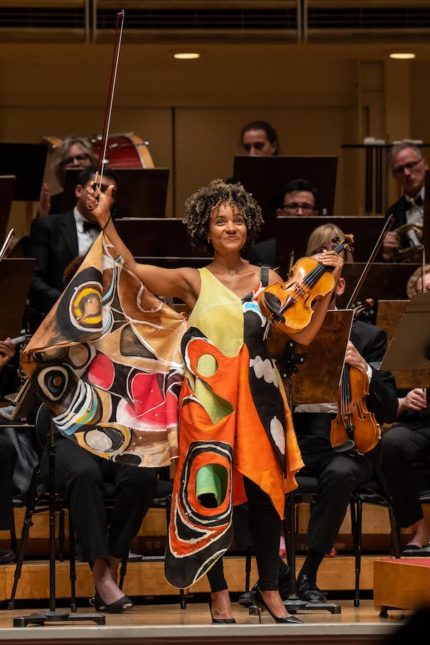Dancers, an interactive dress and audience participation enhance, detract in Chicago Sinfonietta finale

The Chicago Sinfonietta traversed the globe in their final concert of the season, titled “Limitless Horizon,” Monday night at Symphony Center. The innovative program, designed to showcase diversity in both music and representation, featured two world premieres, a flamenco dance troupe, and a transforming concert dress.
First on the program was Arturo Márquez’s Conga del Fuego Nuevo. Built on Cuban rhythms and making extensive use of conga drums and other percussion, the energetic piece was further brought to life by flamenco dancer Wendy Clinard from Clinard Dance. Though flamenco is Spanish in origin, it complemented the Cuban rhythms nicely. Clinard gave an impassioned and compelling performance in a striking red dress and turquoise fringed shawl. Chen led the orchestra in a breezy rendition, though the reprise of the piece as as encore proved more energetic.
Two world premieres followed: Moshe’s Dream by the orchestra’s Project Inclusion Composition Fellow Michelle Isaac and To Be A Horizon by LA-based composer Derrick Skye.
Moshe’s Dream is based on a dream the composer’s 100-year-old grandfather had during lockdown about her forming a klezmer band and writing a piece for him in the klezmer style. As such, the composer employs various klezmer-inspired figures and Eastern European modal inflections, though she does not quote klezmer melodies directly. Isaac writes that the piece is more about conveying her grandfather’s dream and the diverse emotions the musical style can convey than being “a musical reflection on klezmer music.”
Isaac effectively evoked the dream-like state of the piece without resorting to clichés. The first section flirted with polytonality, as each individual line sounded first straightforwardly but then turned Dali-esque in combination, as in a dream where things seem initially realistic before turning bizarre. Overall, the piece is teeming with interesting melodic ideas and textures, though few of these ideas are explored for very long, like fragments of a half-remembered dream. Even so, Moshe’s Dream is still remarkably cohesive, united by the abstracted stylistic influence of Jewish folk music.
Freeman Fellow assistant conductor Taichi Fukumura, in his debut with Chicago Sinfonietta, led the intricate piece with clarity and assuredness. Though this was the only piece on the program without a “gimmick” (i.e., no dancers, costuming, or audience participation), the Sinfonietta’s performance held the audience’s attention all the way through. The ending could have been tighter, as the orchestra seemed to lose energy at the coda.
Skye’s To Be A Horizon brought together multiple cultural influences from around the world, bridging music from the Balkans and Ghana and North Indian Hindustani classical music to create something wholly original. Chen, returning to the podium, kept the ship steady throughout the amorphous introduction in which various instruments play improvisatory solos full of quarter-tone inflections and slides over a bed of sustained strings.
Once the percussion section established a clear beat, a trio of dancers from Clinard Dance took the stage. Each of the dancers brought their own flair to the choreography when dancing as a group and as soloists. The tension inherent in flamenco dancing fit the music well despite it not having any direct Spanish influences. Ballet dancer Antonio Rosario impressed with his soft-footed leaps, long lines, and pirouettes, which starkly contrasted with the more percussive and angular movements of flamenco artist Niño de los Reyes. The program didn’t make clear whether Skye had balletic intentions when he composed To Be A Horizon, yet the choreography made the somewhat esoteric piece work, providing much-needed grounding and direction.
In the second half, the Sinfonietta welcomed violinist Melissa White for Chen Gang and He Zhanhao’s Butterfly Lovers’ Violin Concerto. Chen explained that since White is a frequent collaborator with the ensemble, she wanted to “shake things up” by incorporating another nonmusical element—an interactive dress. Designed and constructed by Carley Brandeaux, the bespoke dress plays an active role in the performance, transforming throughout the piece to symbolize the ill-fated lovers’ reincarnation as butterflies.
In its initial chrysalis-like form, the dress is composed of seemingly haphazard swatches of light yellow and green fabrics. Between movements and at other opportune moments, White unbuttoned portions of the dress to reveal different elements and fabrics underneath, with glimpses of orange hinting at the monarch butterfly underneath. In the final transformation, White attached part of the dress to her right wrist, creating a flowing butterfly wing that waved elegantly as she bowed her violin. Though the deftly constructed dress complemented the story and music well, each time White revealed a new aspect of the costume, it elicited titters of laughter and sporadic claps from the audience, which broke the flow and atmosphere of the music.
The musical performance itself would have been sufficient on its own. Chen brought out the different colors in the orchestra effectively and kept the ensemble in balance with the soloist throughout, while White’s elegant playing was warmly expressive and lyrical without being overwrought. Her high range was especially glittering, and her duets with principal cellist Ann Griffin were a highlight.
Dvořák’s Slavonic Dance, Op. 46, no. 8 capped off the program. Beforehand, Chen instructed the audience to follow assistant directors Fukumura and Kyle Dickson who would lead rhythmic clapping from the sides of the stage during the piece.
Though this exercise succeeded in energizing the crowd, the audience’s untidy percussion almost completely obscured the orchestra’s playing at times and ultimately felt unnecessary. There were enough innovative elements in this concert—with the dancing and metamorphosing dress—that another device was not needed to engage the audience. As was demonstrated in Isaac’s Moshe’s Dream, when the music is good enough, you can trust the audience to enjoy it without assistance.
The Chicago Sinfonietta’s 2022–23 season opens September 17 and 19 with music of Gershwin, Respighi, Roberto Sierra and Nkeiru Okoye. chicagosinfonietta.org
Posted in Performances




